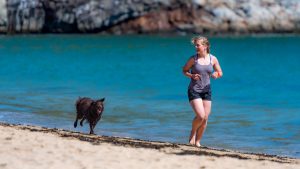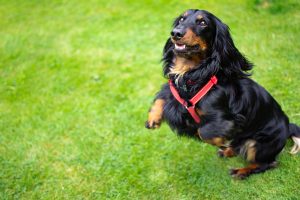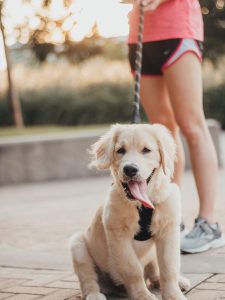After months of stay-at-home orders where your pets may have been thrilled with your companionship, they may have missed out on some quality activity time as many dog parks and other public spaces were closed. Plus, regularly scheduled visits to doggie day care or with pet sitters and dog walkers may have been put on hold, which may also have cut down on important pet exercise time.
And even now as states are reopening, individual comfort levels with being in groups at dog parks or close contact with others may make a return to regular exercise habits something that won’t happen for the foreseeable future. (Here’s a helpful guide to see where your state stands on what is open.) So it’s important to find ways to add exercise for your dog into your routine to keep you both active now.
“Dogs need exercise every day,” says Rosemarie Niznik,” DVM, CVA, CVSMT, a veterinarian in Bristol, WI. “It’s good for their physical wellbeing and weight management, as well as their mental health,” she says. “You need to keep a dog moving. They love to walk—it’s almost how they meditate.”
And just like humans, exercise can help relieve stress in pets, explains Sylvalyn Simpson, DVM, a veterinarian in Austin, TX. “If dogs have too much pent-up energy and don’t receive the appropriate amount of exercise, it can lead to behavioral disorders, destructive behavior, or uncontrollable barking,” she says.
So what’s the appropriate amount? There are three things you need to keep in mind:

Your dog's breed:
Dr. Niznik says to think of what your dog was bred for when considering the amount and type of exercise that’s best for your dog. If your pup was designed to herd or is a member of the working group, they’ll have lots of energy and endurance so you’ll need to keep them mentally and physically engaged more than other dogs.
If you picked a dog with a short snout like a pug, bull breed, Boston terrier, boxer, or shih tzu among others—these are brachycephalic breeds. This literally translates to short-headed. These dogs have flattened faces that appear to be pushed in, and as a result have smaller airways which makes it harder for them to cool down. Dr. Niznik says these breeds can benefit from exercising indoors or during the coolest parts of the day to avoid overheating.
Deep-chested dogs like Doberman Pinschers and Great Danes shouldn’t exercise right after a meal because they are at risk for a condition called gastric dilation-volvulus. This type of bloat can develop after large meals and can be life threatening.
Your dog's age:
Puppies by nature are going to require more stimuli and be more engaged and curious, says Dr. Simpson. They have higher energy levels and will need to divert that energy into physical and mental activity. In general, the younger the dog, the more frequently you’ll need to exercise—but you can keep your sessions shorter.
“With puppies you have to be careful with running on hard surfaces,” Dr. Niznik warns. “You shouldn’t take them on long hard runs until their joints stop growing.” Most puppies shouldn’t run until they are at least a year old. This is especially true with larger breeds like Saint Bernards and Great Danes whose growth plates don’t close until they are about two years old.
And of course senior dogs have likely slowed down a bit. According to the American Animal Hospital Association, senior years are the last 25 percent of a dog’s life expectancy, so depending on the breed this can be as early as when a pooch is 7 or 8 years old. When your dog is in its senior years, go for shorter periods of exercise at a gentler pace to help maintain muscular and cardiovascular health without pushing too hard.
Your dog's weight:
According to Fetch by WebMD, up to (a whopping) 50 percent of dogs are overweight. And if this is your dog, your instinct may be to get them moving as much as possible. However, this could be actually be harmful rather than helpful to your pup’s health. Suddenly increasing activity levels can stress your dog’s joints, spine, and cardiovascular system. It's important to avoid overexerting a dog who’s not used to activity.
Just as with humans, exercise combined with a healthy diet is key in helping your dog maintain an ideal weight. Increasing activity levels can help manage the risk for health conditions like diabetes, arthritis, endocrine disorders, high blood pressure, and cancer. But too much exertion can be unhealthy. It’s best to start out slow and exercise your dog in small amounts and build up over time. And with an overweight dog, it’s important to monitor them for signs of getting overheated if you’re exercising outside. (If your dog starts acting lethargic or panting more than usual, stop and offer some water! If your pet lays down, be sure to get your dog inside immediately and provide a way for him to cool down.)
General pet exercise guidelines:

No matter your dog’s breed, age, or size, there are some guidelines everyone should follow when it comes to exercising your dog.
Talk to your vet
Before you put your dog on an exercise plan, make sure you consult with your veterinarian. Dr. Niznik says your vet can ensure your dog doesn’t have any underlying heart conditions that could limit his ability to exercise. You should also be aware of any kidney disease or liver disorders that would be worsened with physical activity.
Plus, your doctor can spot joint and back issues that might limit the activities you want your pup to partake in. “In general you should consult with your vet to make sure there’s nothing abnormal you need to be aware of before starting a new exercise plan with your dog,” she says.
Your vet can also advise on when is a good time to start giving your dog supplements. “If you have a dog predisposed to hip dysplasia or arthritis, it’s good to do preventative care before the damage is done,” Dr. Niznik says. She often puts dogs on glucosamine or chondroitin when they are three or four years old for joint protection. Dr. Niznik says that Omega-3s can also provide anti-inflammatory benefits that help protect the knees.
Take it slow
“Walking half an hour twice a day is ideal,” Dr. Niznik says. But you can break this up into four 15-minute walks. You can keep the pace slow for older or smaller dogs. The key is to pay attention to your dog and stay at a pace that’s appropriate for him. “Your dog wants to please you and won’t stop until it’s too late and exhaustion sets in,” Dr. Niznik says. “In the summer you risk overheating.”
Dr. Simpson suggests going for more frequent games of fetch or several short walks rather than one long run. This helps you build a more realistic routine that you both will stick to.
Know when to stop
Look for signs that you’re overdoing it like excessive panting. “When your dog’s tongue starts to hang out much longer and turns into a spoon shape, that means he’s getting overheated,” Dr. Niznik warns. "Also if your pup is slowing down or if his face looks stressed, these are warning signs you need to take a break and let your dog cool down."

Be prepared
Before you set out for any form of exercise with your dog, make sure you’ve trimmed his claws. You want to avoid risking snagging or tearing them on anything which can lead to a painful and sometimes serious injury. Dr. Niznik warns that a torn nail on a walk could turn into an emergency.
It's also important to ensure you’re current on any flea and tick medication even if you’re just going on backyard playdates. The threat from parasites and disease is one you don’t want to have to worry about every time you leave the house.
If you’re headed out in the heat, always pack water for your pup. You should make sure you’re prepared to help cool them down. They will be happy to have some to sip, and you can also use it to cool off the pads on their paws to help regulate their temperature.

The good news is exercising with your dog doesn’t require an elaborate plan. Here are the best ways to keep them moving:
In your apartment:
Try a modified form of horse training the American Kennel Club recommends called cavaletti. Set up an obstacle course with pool noodles or PVC pipes, and have your pup step over them in different formations and heights. Or set up your own improvised obstacle courses with sofa cushions and guide your dog through them with a treat. If your dog is able you can play fetch on the stairs or roll a ball across the floor.
In your yard:
Fetch is a great option but stick to a ball or a Frisbee. Dr. Niznik has seen dogs get injured with sticks. “Not only can a dog pick up a stick and chew it which can damage its mouth,” she explains, “but it’s possible for a stick to go down its throat and get lodged in the esophagus—especially if the dog is running at a high speed.”
You can also set up obstacle courses outdoors for more agility work and mental engagement for dogs that need more stimulation.
 On the sidewalk:
On the sidewalk:
“Walking is fun and easy for you and the dog—it’s one of the best things you can do,” Dr. Simpson says. "You should try to go on one walk a day outside of the house or yard to decrease boredom for your dog and reap all the benefits of exercise."
Allow for sniff breaks—you don’t have to keep a high-intensity pace the entire time.
The American Kennel Club suggests walking with a sturdy, non-retractable leash for more control, and a harness rather than a collar to avoid stressing the neck. If you’re going for a run, check with your vet to make sure your dog’s age, size, and breed are suited for it.
On the trail:
“Trails are usually nicer for walks because they are usually more shady and the ground is dirt or grass rather than asphalt,” Dr. Simpson says. These are great ways to work on your dog’s agility by letting them walk on uneven terrain and experience different stimuli.
Dr. Niznik suggests keeping your dog on a lead because they’re like kids and will naturally want to run without thinking what’s on the other side of a rock or cliff. And there is a risk of snakes or other wildlife that could also cause your dog to act unpredictably. Keep your dog with you at all times to avoid trouble.
In the water:
“Swimming can be extremely beneficial because you can get a full-body workout with minimal stress on joints—and they stay cool,” Dr. Simpson says. She advises putting your dog in a life jacket and staying with them at all times in the water. “Swimming isn’t intuitive for all dogs and stockier dogs tend to sink,” she says. “But a life jacket is a huge help so they can enjoy the water.”
You can play fetch or keep-away in the water just as you do on land and will soon have an exhausted and happy pup.
~~~
Tell us: What are some of your dog's favorite types of exercise and activities?

